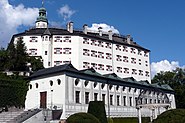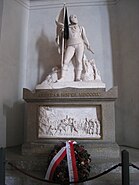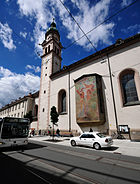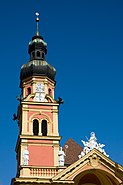| Main | Births etc |
|---|
| Innsbruck | |||
|---|---|---|---|
| Innsbruck | |||
|
|||
| Coordinates: Coordinates: | |||
| Country | Austria | ||
| State | Tyrol | ||
| District | Statutory city | ||
| Area | |||
| • Total | 104.91 km2 (40.51 sq mi) | ||
| Elevation | 574 m (1,883 ft) | ||
| Population (1 January 2014)[1] | |||
| • Total | 121,329 | ||
| • Density | 1,200/km2 (3,000/sq mi) | ||
| Time zone | CET (UTC+1) | ||
| • Summer (DST) | CEST (UTC+2) | ||
| Postal codes | 6010–6080 | ||
| Area code | 0512 | ||
| Vehicle registration | I | ||
| Website | innsbruck.at | ||
Innsbruck (pronounced [ˈɪnsbʀʊk]) is the capital city of the federal state of Tyrol (Tirol) in western Austria. It is located in the Inn Valley at the junction with the Wipptal (Sill River), which provides access to the Brenner Pass, some 30 km (18.6 mi) south of Innsbruck. It is about half way between Munich (Germany) and Verona (Italy). Located in the broad valley between high mountains, the Nordkette (Hafelekar, 2,334 metres or 7,657 ft) in the north, Patscherkofel (2,246 m or 7,369 ft) and Serles (2,718 m or 8,917 ft) in the south. It is an internationally renowned winter sports centre, and hosted the 1964 and 1976 Winter Olympics as well as the 1984 and 1988 Winter Paralympics. Innsbruck hosted the first Winter Youth Olympics in 2012. The word bruck comes from the same root as the modern German word "Brücke" meaning "bridge" which leads to "the bridge over the Inn".[2]
History[]
Earliest traces suggest initial inhabitation in the early Stone Age. Surviving pre-Roman place names show that the area has been populated continuously. In the 4th century the Romans established the army station Veldidena (the name survives in today's urban district Wilten) at Oenipons (Innsbruck), to protect the economically important commercial road from Verona-Brenner-Augsburg.
The first mention of Innsbruck dates back to the name Oeni Pontum or Oeni Pons which is Latin for bridge (pons) over the Inn (Oenus), which was an important crossing point over the Inn river. The Counts of Andechs acquired the town in 1180. In 1248 the town passed into the hands of the Counts of Tyrol.[3] The city's seal and coat of arms show a bird's-eye view of the Inn bridge, a design used since 1267. The route over the Brenner Pass was then a major transport and communications link between the north and the south, and the easiest route across the Alps. The revenues generated by serving as a transit station enabled the city to flourish.

View of Innsbruck by Albrecht Dürer, 1495
Innsbruck became the capital of all Tyrol in 1429 and in the 15th century the city became a centre of European politics and culture as Emperor Maximilian I also resided in Innsbruck in the 1490s. The city benefited from the emperor's presence as can be seen for example in the Hofkirche. Here a funeral monument for Maximilian was planned and erected partly by his successors. The ensemble with a cenotaph and the bronze statues of real and mythical ancestors of the Habsburgian emperor are one of the main artistic monuments of Innsbruck. A regular postal service between Innsbruck and Mechelen was established in 1490 by the Thurn-und-Taxis-Post.

Ambras Castle, 1679
In 1564 Ferdinand II, Archduke of Austria received the rulership over Tirol and other Further Austrian possessions administrated from Innsbruck up to the 18th century. He had Schloss Ambras built and arranged there his unique Renaissance collections nowadays mainly part of Vienna's Kunsthistorisches Museum. Up to 1665 a stirps[4] of the Habsburgian dynasty ruled in Innsbruck with an independent court. In the 1620s the first opera house north of the Alps was erected in Innsbruck (Dogana).
In 1669 the university was founded. Also as a compensation for the court as Emperor Leopold I again reigned from Vienna and the Tyrolean stirps of the Habsburg dynasty had ended in 1665.[5]

Andreas Hofer with his Consultants at the Hofburg by Franz Defregger, 1879
During the Napoleonic Wars Tyrol was ceded to Bavaria, ally of France. Andreas Hofer led a Tyrolean peasant army to victory in the Battles of Bergisel against the combined Bavarian and French forces, and then made Innsbruck the centre of his administration. The combined army later overran the Tyrolean militia army and until 1814 Innsbruck was part of Bavaria. After the Vienna Congress Austrian rule was restored. Until 1918, the town (one of the 4 autonomous towns in Tyrol) was part of the Austrian monarchy (Austria side after the compromise of 1867), head of the district of the same name, one of the 21 Bezirkshauptmannschaften in the Tyrol province.[6]
The Tyrolean hero Andreas Hofer was executed in Mantua; his remains were returned to Innsbruck in 1823 and interred in the Franciscan church.
In 1929, the first official Austrian Chess Championship was held in Innsbruck.
In 1938 Austria was annexed by Nazi Germany in the Anschluss. Between 1943 and April 1945, Innsbruck experienced twenty-two bomb attacks and suffered heavy damage.
Population[]
| Historical population | ||
|---|---|---|
| Year | Pop. | ±% |
| 1900 | 49,727 | — |
| 1951 | 95,055 | +91.2% |
| 1961 | 100,959 | +6.2% |
| 1971 | 116,104 | +15.0% |
| 1981 | 117,287 | +1.0% |
| 1991 | 118,112 | +0.7% |
| 2001 | 113,392 | −4.0% |
| 2007 | 117,915 | +4.0% |
Climate[]
Due to its altitude and position in Central Europe far from the coast, Innsbruck has a Continental climate (Köppen classification: Dfb). Winters are cold (colder than those of most major European cities) and snowy. Winter nights can get frigid, occasionally dropping to −12 °C (10.4 °F).
Spring is brief; days start to get warm, often over 15 °C (59 °F), but nights remain cool or even freezing.
Summer is highly variable and unpredictable. Days can be cool 17 °C (63 °F) and rainy, or sunny and extremely hot, sometimes hitting 34 °C (93 °F). In summer, as expected for an alpine climate, the diurnal temperature variation is often very high as nights always remain cool, being 12 °C (54 °F) on average, but sometimes dipping as low as 6 °C (43 °F).
The average annual temperature is 9 °C (48 °F).
| Climate data for Innsbruck-Flugplatz (LOWI) | |||||||||||||
|---|---|---|---|---|---|---|---|---|---|---|---|---|---|
| Month | Jan | Feb | Mar | Apr | May | Jun | Jul | Aug | Sep | Oct | Nov | Dec | Year |
| Record high °C (°F) | 20.2 (68.4) |
18.6 (65.5) |
23.9 (75.0) |
26.4 (79.5) |
32.2 (90.0) |
33.6 (92.5) |
37.7 (99.9) |
35.0 (95.0) |
32.1 (89.8) |
26.0 (78.8) |
21.2 (70.2) |
17.1 (62.8) |
37.7 (99.9) |
| Average high °C (°F) | 3.5 (38.3) |
6.3 (43.3) |
11.3 (52.3) |
14.8 (58.6) |
20.3 (68.5) |
22.6 (72.7) |
24.7 (76.5) |
24.4 (75.9) |
20.8 (69.4) |
15.8 (60.4) |
8.2 (46.8) |
3.7 (38.7) |
14.7 (58.5) |
| Daily mean °C (°F) | −1.7 (28.9) |
0.4 (32.7) |
4.8 (40.6) |
8.4 (47.1) |
13.4 (56.1) |
16.1 (61.0) |
18.1 (64.6) |
17.7 (63.9) |
14.0 (57.2) |
9.1 (48.4) |
2.9 (37.2) |
−1 (30.2) |
8.5 (47.3) |
| Average low °C (°F) | −5.2 (22.6) |
−3.7 (25.3) |
0.2 (32.4) |
3.4 (38.1) |
7.8 (46.0) |
10.8 (51.4) |
12.8 (55.0) |
12.7 (54.9) |
9.3 (48.7) |
4.8 (40.6) |
−0.5 (31.1) |
−4.2 (24.4) |
4.0 (39.2) |
| Record low °C (°F) | −23.8 (−10.8) |
−17.3 (0.9) |
−16.5 (2.3) |
−4.8 (23.4) |
−2.3 (27.9) |
3.0 (37.4) |
4.4 (39.9) |
1.9 (35.4) |
−0.9 (30.4) |
−6.6 (20.1) |
−17.9 (−0.2) |
−20.1 (−4.2) |
−23.8 (−10.8) |
| Precipitation mm (inches) | 43.9 (1.728) |
41.4 (1.63) |
55.9 (2.201) |
57.7 (2.272) |
87.1 (3.429) |
110.3 (4.343) |
137.2 (5.402) |
111.3 (4.382) |
78.1 (3.075) |
57.3 (2.256) |
63.2 (2.488) |
53.1 (2.091) |
896.5 (35.295) |
| Snowfall cm (inches) | 25.6 (10.08) |
30.0 (11.81) |
12.5 (4.92) |
3.5 (1.38) |
0.0 (0) |
0.0 (0) |
0.0 (0) |
0.0 (0) |
0.0 (0) |
0.8 (0.31) |
12.0 (4.72) |
25.9 (10.2) |
110.3 (43.43) |
| Avg. precipitation days (≥ 1.0 mm) | 7.4 | 7.3 | 8.8 | 9.7 | 10.7 | 13.2 | 13.9 | 12.6 | 9.2 | 7.8 | 9.0 | 8.6 | 118.2 |
| Avg. snowy days (≥ 1.0 cm) | 20.3 | 14.8 | 6.2 | 1.9 | 0.0 | 0.0 | 0.0 | 0.0 | 0.0 | 0.3 | 5.1 | 16.5 | 65.1 |
| Mean monthly sunshine hours | 94.7 | 121.1 | 154.2 | 168.2 | 193.0 | 186.8 | 215.5 | 214.4 | 180.0 | 159.0 | 102.2 | 82.8 | 1,871.9 |
| Source: Central Institute for Meteorology and Geodynamics[7] data of sunshine hours from the nearby university station[8] | |||||||||||||
Main sights[]
Buildings and monuments[]

Imperial Hofburg (Kaiserliche Hofburg)

Goldenes Dachl (Golden Roof)
- Alte Innbrücke (Old Inn Bridge)
- Ambras Castle
- Andreas Hofer's tomb
- Annasäule (Anna Pillar)
- Bergiselschanze (Bergisel Tower)
- Büchsenhausen Castle
- Casino Innsbruck
- City Hall (Stadtsaal)
- Goldenes Dachl (Golden Roof)
- Helblinghaus
- Hofburg (Imperial Palace)
- Hungerburgbahn
- Leopold Brunnen (Leopold's Fountain)
- Maria-Theresien-Straße
- Maximilian's Cenotaph and the Black Men (Schwarzen Männer)
- Old Federal State Parliament (Altes Landhaus)
- Old Town (Altstadt)
- Silberne Kapell (Silver Chapel)
- Stadtturm (City Tower)
- Triumphal Arch (Triumphpforte)
- Tyrolean State Theatre
Museums[]
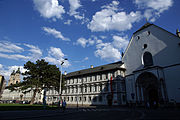
Tyrolean Folk Art Museum next to the Hofkirche in Innsbruck
- Alpine Club Museum
- Ambras Castle
- Armoury
- City Archives
- Grassmayr Bell Foundry and Museum
- Innsbruck Stubaital station
- Kaiserjäger Museum
- Riesenrundgemälde
- Tyrolean Folk Art Museum (Tiroler Volkunstmuseum)
- Tyrolean State Museum (Tiroler Landesmuseum or Ferdinandeum)
- Tyrolean Museum Railways (Tiroler Museumsbahnen)
Churches[]

Innsbruck Cathedral (Dom zu St. Jakob)
- Hofkirche (Court Church)
- Innsbruck Cathedral (Dom zu St. Jakob)
- Jesuit Church
- Liebfrauenkirche
- Mariahilfkirche
- Servitenkirche
- Spitalskirche
- Ursulinenkirche
- Wilten Abbey (Stift Wilten)
- Wilten Basilica (Wiltener Basilika)
Parks and gardens[]
- Alpine Zoo (Alpenzoo)
- Innsbruck University Botanic Garden
- Hofgarten (Court Garden)
- Rapoldipark
- Schlosspark Ambras
Gallery[]

Panoramic view looking north
Cultural events[]
As a very popular tourist destination, Innsbruck organizes the following events every year:
- Innsbrucker Tanzsommer
- Bergsilvester (New Year's Eve)
- Festwochen der Alten Musik (Weeks of Ancient Music)
- Christkindlmarkt (Christmas fair)
- Tyrolean Evenings with the Gundolf Family at the Sandwirt Restaurant website
Sports[]

Bergiselschanze ski jumping facility
Due to its location between high mountains, Innsbruck serves as an ideal place for skiing in winter, and mountaineering in summer. There are several ski resorts around Innsbruck, with the Nordkette served by a cable car and additional chair lifts further up. Other ski resorts nearby include Axamer Lizum, Muttereralm, Patscherkofel, Igls, Seefeld, Tulfes and Stubai Valley. The glaciated terrain in the latter makes skiing possible even in summer months.
The Winter Olympic Games were held in Innsbruck twice, first in 1964, then again in 1976, when Colorado voters rejected a bond referendum in 1972 to finance the Denver games, originally awarded in 1970. The 1976 Winter Olympics were the last games held in the German-speaking Alps (Austria, Germany, or Switzerland).
Along with St. Moritz, Switzerland and Lake Placid, New York in the United States, it is one of three places which have twice hosted the Winter Games. It also hosted the 1984 and 1988 Winter Paralympics.
Innsbruck hosted the 1st Winter Youth Olympic Games in 2012.[9]
Other notable events held in Innsbruck include the Air & Style Snowboard Contest from 1994 to 1999 and 2008 and the Ice Hockey World Championship in 2005. Together with the city of Seefeld, Innsbruck organized the Winter Universiade in 2005. Innsbruck's Bergiselschanze is one of the hills of the famous Four Hills Tournament.
Innsbruck is home to the football club FC Wacker Innsbruck, which plays in the Austrian Football Bundesliga (first tier) in 2010–11. FC Wacker Innsbruck's stadium, Tivoli Neu, is one of eight stadiums which hosted Euro 2008 which took place in Switzerland and Austria in June 2008.
The city also hosted an American Football final, Eurobowl XXII between the Swarco Raiders Tirol and the Raiffeisen Vikings Vienna.
The city hosted opening round games in the 2011 IFAF World Championship, the official international American Football championship.
Economy and education[]
Innsbruck is the cultural and economic centre of western Austria. It is also one of the most famous and substantial tourist centres, with more than a million overnight stays. Innsbruck is a university city, with several locally based colleges (or universities).
In Innsbruck, there are some 78,000 employees and about 8,000 places of work. Nearly 35,000 people shuttle every day into Innsbruck from the surrounding communities in the area.
Tourism[]
Tourism is the most important source of income for the city authority, largely because of Innsbruck's beautiful town centre with its historic buildings, the friendly ambience and the extensive sport facilities both in winter and in summer.
Transport[]

Innsbruck Airport
Innsbruck is located along the A12/A13 corridor, providing freeway access to Verona, Italy and Munich, Germany. The A12 and A13 converge near Innsbruck, at which point the A13 terminates.
Innsbruck Hauptbahnhof, the most important railway station of Innsbruck and Tyrol, is one of the busiest railway stations in Austria. It is served by the Lower Inn Valley line to Germany and eastern Austria, the Arlberg line to the west and the Brenner line, which connects northern Italy with southern Germany via the Brenner pass. Since December 2007 suburban services have been operated as the Innsbruck S-Bahn.
Innsbruck Airport is located in the suburb of Kranebitten, which is located in the west of the city. It provides services to airports including Frankfurt, London, and Vienna. It also handles regional flights around the Alps, as well as seasonal flights to other destinations. During the winter, activity increases significantly, due to the high number of skiers travelling to the region. It is the main base of Welcome Air and Austrian Airlines' regional carrier Tyrolean Airways. The airport is approximately 4 kilometres (2.5 mi) from the centre of Innsbruck.

Trambahn in Innsbruck
Local public transport is provided by Innsbrucker Verkehrsbetriebe (IVB), a public authority operating a network of bus and tram routes. The metre-gauge tram network consists of two city lines, 1 and 3, and two lines serving the surrounding area: line 6, the Innsbrucker Mittelgebirgsbahn to Igls, and line STB, the Stubaitalbahn running through the Stubai Valley to Fulpmes. The network is planned to be enlarged during the coming years to reach Hall in Tirol in the east and Völs in the west (thus replacing a former tram line [closed in the late 1960s] from Innsbruck to Solbad Hall, as Hall in Tirol was then known). Numerous bus lines serve the inner city and connect it with surrounding areas. Until 2007 the bus network included two trolleybus routes, but these were abandoned in preparation for planned expansion of the tram network.
In December 2007, the Hungerburgbahn, a funicular service to the district of Hungerburg, was reopened after a two-year closure for extensive rebuilding, with partial realignment and a new extension across the Inn River and into central Innsbruck. The line was also equipped with new vehicles. The rebuilt line is operated by a private company, Innsbrucker Nordkettenbahnen.
Education[]
Innsbruck is home to the oldest grammar school (Gymnasium) of Western Austria, the "Akademisches Gymnasium Innsbruck". The school was founded in 1562 by the Jesuit order and was the precursor of the university, founded in 1669.
Innsbruck hosts several universities. The most well-known are the University of Innsbruck (Leopold-Franzens-Universität), the Innsbruck Medical University, and the university of applied sciences MCI Management Center Innsbruck.
Politics[]

Panoramic view looking down
The results of the 2012 local elections were:
- Für Innsbruck 21% (conservative)
- Social Democratic Party of Austria 14.5% (left)
- Austrian Green Party 19.1% (left)
- Austrian People's Party 21.9% (conservative)
- Freie Liste Rudi Federspiel 7.9% (right)
- Freedom Party of Austria 7.7% (right)
- Pirate Party Tyrol 3.8%
Organizations[]
- The international headquarters of SOS Children's Villages, one of the world's largest charities, is located in Innsbruck.
- The internationally active NGO Austrian Service Abroad was founded in Innsbruck in 1992 by Andreas Maislinger and Andreas Hörtnagl. Its central office is located at Hutterweg, Innsbruck.
- Innsbruck has two universities, the Leopold-Franzens-Universität Innsbruck and the Innsbruck Medical University. The Innsbruck Medical University has one of Europe's premier ski injury clinics.
- The international headquarters of MED-EL, one of the largest producers of cochlear implants, is located in Innsbruck.
- The Aouda.X space suit simulator is being developed by the OeWF in Innsbruck. Also, the Mission Support Center for many of the OeWF Mars analogue missions is situated in the city. This MSC used time delayed communication with Camp Weyprecht in the desert near Erfoud, Morocco for the MARS2013 expedition during February 2013.
International relations[]
Twin towns and sister cities[]
Partnerships[]Austrian Service Abroad[]The Austrian Service Abroad is a NGO, which provides positions for an alternative Austrian national service at 85 organizations in 35 countries worldwide in the sectors Holocaust Memorial Service, Social Service and Peace Service. It was founded by Andreas Maislinger and Andreas Hörtnagl in 1998 and is based in Innsbruck. See also[]
References[]
Further reading[]
External links[]Wikimedia Commons has media related to:
Template:Principal cities of Austria
Template:Paralympic Winter Games Host Cities Template:Youth Olympic Games Host Cities
|
|||||||||||||||||||||||||||||||



